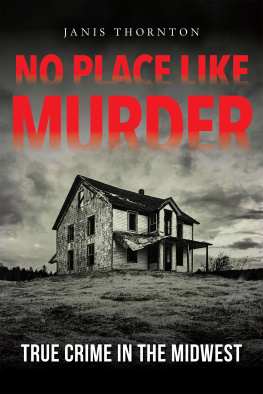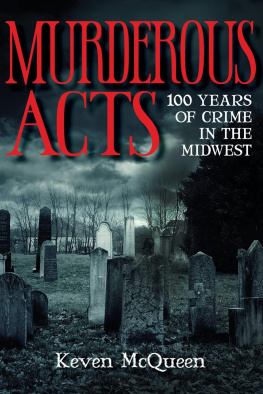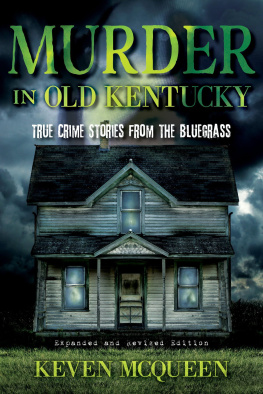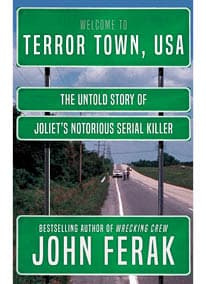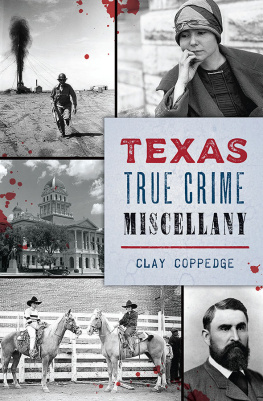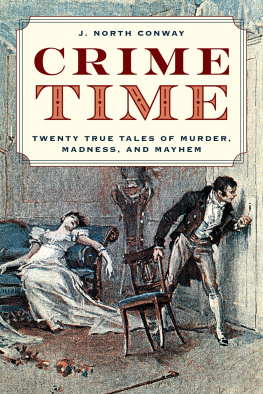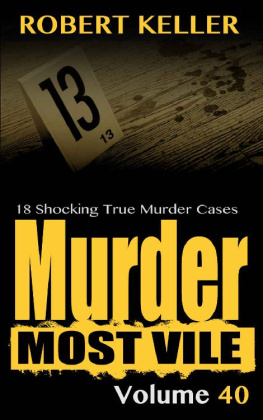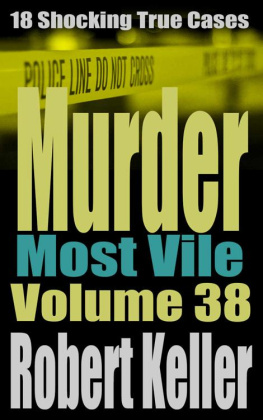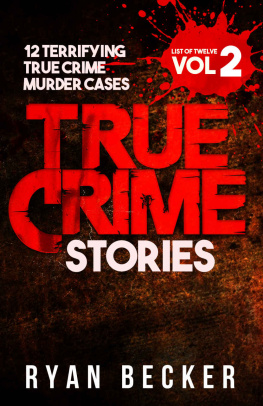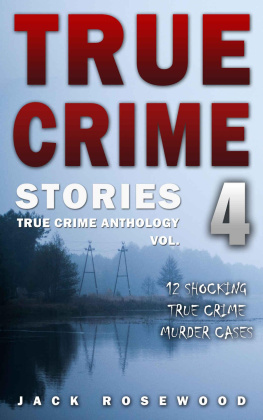Janis Thornton - No Place Like Murder: True Crime in the Midwest
Here you can read online Janis Thornton - No Place Like Murder: True Crime in the Midwest full text of the book (entire story) in english for free. Download pdf and epub, get meaning, cover and reviews about this ebook. year: 2020, publisher: Indiana University Press, genre: Non-fiction. Description of the work, (preface) as well as reviews are available. Best literature library LitArk.com created for fans of good reading and offers a wide selection of genres:
Romance novel
Science fiction
Adventure
Detective
Science
History
Home and family
Prose
Art
Politics
Computer
Non-fiction
Religion
Business
Children
Humor
Choose a favorite category and find really read worthwhile books. Enjoy immersion in the world of imagination, feel the emotions of the characters or learn something new for yourself, make an fascinating discovery.
- Book:No Place Like Murder: True Crime in the Midwest
- Author:
- Publisher:Indiana University Press
- Genre:
- Year:2020
- Rating:5 / 5
- Favourites:Add to favourites
- Your mark:
- 100
- 1
- 2
- 3
- 4
- 5
No Place Like Murder: True Crime in the Midwest: summary, description and annotation
We offer to read an annotation, description, summary or preface (depends on what the author of the book "No Place Like Murder: True Crime in the Midwest" wrote himself). If you haven't found the necessary information about the book — write in the comments, we will try to find it.
No Place Like Murder: True Crime in the Midwest — read online for free the complete book (whole text) full work
Below is the text of the book, divided by pages. System saving the place of the last page read, allows you to conveniently read the book "No Place Like Murder: True Crime in the Midwest" online for free, without having to search again every time where you left off. Put a bookmark, and you can go to the page where you finished reading at any time.
Font size:
Interval:
Bookmark:

NO PLACE LIKE MURDER
JANIS THORNTON
NO PLACE LIKE
MURDER
TRUE CRIME IN THE MIDWEST
Forewords by Larry Sweazy and Ray E. Boomhower

This book is a publication of
Quarry Books
an imprint of
INDIANA UNIVERSITY PRESS
Office of Scholarly Publishing
Herman B Wells Library 350
1320 East 10th Street
Bloomington, Indiana 47405 USA
iupress.org
2020 by Janis Thornton
All rights reserved
No part of this book may be reproduced or utilized in any form or by any means, electronic or mechanical, including photocopying and recording, or by any information storage and retrieval system, without permission in writing from the publisher.
The paper used in this publication meets the minimum requirements of the American National Standard for Information SciencesPermanence of Paper for Printed Library Materials, ANSI Z39.481992.
Manufactured in the United States of America
Cataloging information is available from the Library of Congress.
ISBN 978-0-253-05277-3 (hardback)
ISBN 978-0-253-05278-0 (paperback)
ISBN 978-0-253-05279-7 (ebook)
First printing 2020
This collection of stories is a tribute to the innocent victims whose time on earth was deliberately and viciously cut short. Among them, and most heartbreaking, are four children: Dee McClure, age two, and his brother Homer, age three; eight-year-old Mollie King; and eleven-year-old Mary Elizabeth Breeden. Their precious lives were stolen from them almost before they began; and even worse, they were taken by someone they had trusted and loved. Rest in peace, sweet angels.
CONTENTS
BY LARRY D. SWEAZY |
BY RAY E. BOOMHOWER |
FOREWORD
WHEN I WAS FOURTEEN, I CAME DOWN WITH MONONUCLEOSIS. IT was the spring of 1974that perfect time of the year when the grass is starting to turn green, the robins are nesting, and the mundane gloominess of winter begins to wash away with the fortuitous rains. It was time to get outside, hang out with my friends, and get as far away from my parents as I could. Instead, I was confined to bed for a month. Doctors orders. No ifs, ands, or buts. Televisions were a luxury, and we had only one in the house. It was in the living room, and it was one of those twenty-inch screens set inside a wood cabinet that took up half of the wall. If I wanted to watch TV, Id have to lie on the couch (called a davenport by my mom). That wasnt practical when everyone else was home, which meant I was left to watch game shows in the morninggreat for a day or twoand soap operas in the afternoon. Boredom set in fast. Lucky for me, my mom borrowed a Time-Life encyclopedia from one of her friends, hoping it would take me a while to read as I recuperated. The encyclopedia wasnt one of those twenty- or thirty-volume sets but rather three thick volumes dedicated to the most notorious criminals of the twentieth century. Before long, I was immersed in the horrible deeds perpetrated by Lizzie Borden, Leopold and Loeb, and the Boston Stranglerand my love of true crime was born.
I would go on to read Helter Skelter, by Vincent Bugliosi and Curt Gentry, which was published in 1974, and instead of being afraid of the bogeyman, I feared Charles Manson and his followers. Then in the 1980s, I discovered Ann Rule, another vaunted contributor to the true crime genre. As much as I enjoyed those books, my own path to becoming a writer followed the fiction path, a mystery and crime fiction path. Its little surprise that one of my books, A Thousand Falling Crows, follows the aftermath of a shootout with Bonnie and Clydean idea born, no doubt, while I suffered from mono and read that encyclopedia from cover to cover. I read a lot of those stories three and four times.
This book reaffirms my appreciation for true crime writing in an unexpected way. Lizzie Borden, Leopold and Loeb, and the Boston Strangler are legendary; they have received the Hollywood treatment (more than once) and are forever imprinted in our popular culture. Janis Thornton, on the other hand, brings us stories that are mostly unknown outside the small towns where the crimes occurred.
I grew up in the small two-stoplight town of Chesterfield, Indiana (Madison County), so the sense of place of these stories feels familiar. And so do the people. I discovered stories of events that took place outside my back door in this wonderfully informative and entertaining volume of local true crimestories I had never heard of before. I was introduced to fifteen-year-old Isabelle Messmer, the Gun Girl from Elwood, who, starting in 1933, went on a decade-long crime spree from Pittsburgh, Pennsylvania, to Texas, and back to Indiana. She was Indianas own Bonnie Harper before anybody had heard of Bonnie and Clyde. And I learned about Grover Blake, who murdered his mother in 1908, in Anderson, Indiana (where I was born), for reasons Ill let you discover on your own.
To say No Place Like Murder reignited my interest in local true crime stories is an understatement. Each story was a revelation, new to me, which, of course, made me wonder why I hadnt heard of these stories before now. Thankfully, the author has painstakingly put together a collection that informs readers about the heinous crimes and goes the extra mile to honor the victims. As sad as The Awful Crime of Jesse McClure is, Thornton humanizes the tale as the murderer, sentenced to life in prison, meets his maker sooner than planned. A similar outcome is revealed in the story of Dan Snider and the Strychnine Solution. Justice is served long after the law had delivered and executed its sentence. Both of these stories involve the murder of childrencrimes so horrible that one would think the stories would endure forever. But they havent, until now, until a memory monument was built of words and pages by the author.
I feel lucky to have grown up when I did, where I did, with parents who were readers and who did not censor the books that passed through my hands, my heart, and my mind. I wholeheartedly believe that those weeks spent in bed with mono were some of the most formative of my early creative life. Not only did I discover true crime fiction, but I also encountered interesting characters, sadness and triumph, and a sense of justice that I didnt know existed. I hope you, dear reader, will experience some of the same emotions in No Place Like Murder that I did. Janis Thornton has performed a wonderful service bringing these lesser-known stories to our attention.
Sadly, crime can occur anywhere, anytimenext door, to people we love, or to friends of friends. But time after time, in story after story, justice usually finds a way to be served. Or it doesnt. Which means the story is not yet over. Even a hundred years later. We may hope that the memory of the crime will live on until the final truth is known, just as it is in these stories.
Larry D. Sweazy
Noblesville, Indiana
March 16, 2019
FOREWORD
On January 15, 1951, in Ann Arbor, Michigan, an unknown assailant crept up behind Pauline Campbell, a thirty-four-year-old nurse on her way home from work, and viciously smashed her in the skull with a heavy rubber mallet. The murder sent shock waves through the quiet college town (home to the University of Michigan campus), with police believing the crime had been committed by a maniac.
Residents were stunned when, a few days after the murder, police were tipped off that three young men from the nearby town of YpsilantiBill Morey Jr., Max Pell, and Dave Royalhad committed the crime, with Morey doing the actual killing. A jury found Morey and Pell guilty of first-degree murder and sentenced them to life in prison (Michigan did not have the death penalty at the time) without the chance for parole, and Royal was convicted of second-degree murder and received a jail sentence of twenty-two years to life. Moreys fathers reaction to the newsI cant believe it; I just cant believe itreflected what many parents in the community were thinking.
Next pageFont size:
Interval:
Bookmark:
Similar books «No Place Like Murder: True Crime in the Midwest»
Look at similar books to No Place Like Murder: True Crime in the Midwest. We have selected literature similar in name and meaning in the hope of providing readers with more options to find new, interesting, not yet read works.
Discussion, reviews of the book No Place Like Murder: True Crime in the Midwest and just readers' own opinions. Leave your comments, write what you think about the work, its meaning or the main characters. Specify what exactly you liked and what you didn't like, and why you think so.

